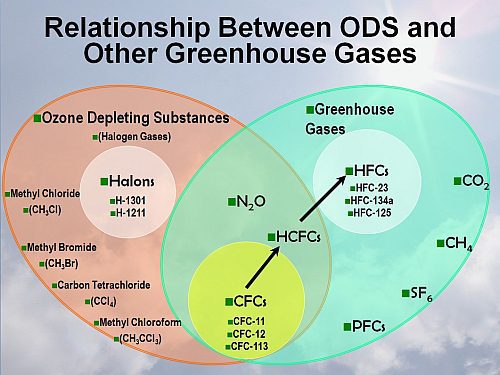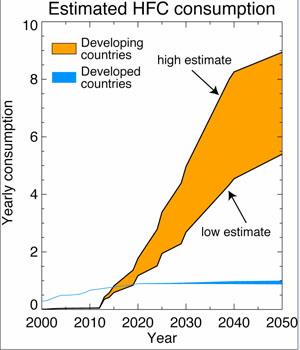 Following through on President Obama’s Climate Action Plan, the U.S. Environmental Protection Agency (EPA) has added five chemicals with low Global Warming Potential (GWP) and which don’t deplete the ozone layer to its list of approved refrigerants. The EPA’s final rule also conforms and advances the decades-long international effort to eliminate the use of chemicals that deplete the ozone layer, which shields life on earth from destructive ultraviolet (UV) radiation from the sun.
Following through on President Obama’s Climate Action Plan, the U.S. Environmental Protection Agency (EPA) has added five chemicals with low Global Warming Potential (GWP) and which don’t deplete the ozone layer to its list of approved refrigerants. The EPA’s final rule also conforms and advances the decades-long international effort to eliminate the use of chemicals that deplete the ozone layer, which shields life on earth from destructive ultraviolet (UV) radiation from the sun.
Having taken into account feedback and input from industry, environmental groups and other stakeholders, the EPA approved ethane, isobutane, propane, R-441A (a blend of hydrocarbons) and HFC-32 (difluoromethane) for use in various types of refrigeration and air conditioning applications under the SNAP (Significant New Alternatives Policy) Program established under the Clean Air Act, the federal environmental agency announced March 2.
“Today’s rule is an example of how we can turn the challenge of climate change into an opportunity to innovate our way to a better future,” EPA Administrator Gina McCarthy was quoted as saying. “By working together, businesses and EPA are bringing new, climate-friendly refrigerants to market that better protect our health and the environment.”
The search for new climate-friendly refrigerants
Though present in minuscule quantities (an average 0.6 parts per million (PPM)), the ozone layer absorbs 97-99 percent of the sun’s medium frequency ultraviolet radiation. In the 1970s, scientists raised the alarm about CFC emissions depleting ozone (O3) in the lower stratosphere (some 12-19 miles above the Earth’s surface) threatening all forms of life. International policy makers and national leaders acknowledged this assessment and took action by signing the Vienna Convention on the Protection of the Ozone Layer in 1985, and the subsequent signing and ratification of the Montreal Protocol (in 1987 and 1989, respectively).

The two most widely adopted multilateral environmental agreements (MEAs) to date, the Vienna Convention and Montreal Protocol are administered by the UN Environment Programme’s (UNEP) Ozone Secretariat. The Montreal Protocol establishes targets and schedules for developed and developing countries party to the international treaties to phase out and eventually eliminate production, use, and emissions of eight groups of widely used chlorine and bromine gases responsible for depletion of the ozone layer. This list includes all CFCs and HCFCs.
Here in the U.S., the Clean Air Act gives the EPA the authority to evaluate substitute chemicals and technologies that are safe for the ozone layer as part of the SNAP Program. The agency briefly elaborated on its approval of five additional low-GWP hydrocarbon refrigerants subject to use conditions in the following refrigeration and air-conditioning applications:
- Ethane in very low temperature refrigeration and in non-mechanical heat transfer;
- Isobutane in retail food refrigeration (stand-alone commercial refrigerators and freezers) and in vending machines;
- Propane in household refrigerators, freezers, or combination refrigerators and freezers, in vending machines, and in room air conditioning units;
- The hydrocarbon blend R-441A in retail food refrigeration (stand-alone commercial refrigerators and freezers), in vending machines and in room air conditioning units; and
- HFC-32 (difluoromethane) in room air conditioning units. HFC-32 has one-third the GWP of the conventional refrigerants currently being used in room air conditioning units.
Except for HFC-32, the EPA is also exempting these low-GWP refrigerants from Clean Air Act regulations that prohibit venting, “as current evidence suggests that their venting, release, or disposal does not pose a threat to the environment.”
Refrigerants, global warming and the ozone layer
Approval of these low-GWP alternatives should boost their uptake and use across industry and economic sectors, pushing out use of refrigerants with higher GWP. As the EPA explains:
“This final rule expands the list of SNAP-approved substitutes to include more low-global warming potential (GWP) alternatives that can replace both the ozone-depleting substances and high-GWP hydrofluorocarbons (HFCs). The approved substitutes have GWPs that range from 3 to 675 and can replace older compounds with GWPs between 1400 to 4000.”
 The EPA’s approval of low-GWP substitutes should add momentum to international efforts to phase out ozone-depleting chemicals and reduce greenhouse gas (GHG) emissions.
The EPA’s approval of low-GWP substitutes should add momentum to international efforts to phase out ozone-depleting chemicals and reduce greenhouse gas (GHG) emissions.
Under the Montreal Protocol, production, use and emissions of CFCs were phased out worldwide in the mid-1990s. The complete phase-out of a group of halon gases and other CFCs was completed in 2010. The phase-out of HCFCs – R-22 being the most widely used – began in 1996 and is slated to be complete across the EU and all 197 national governments party to the Montreal Protocol by 2030. Under the terms of the MP, developing countries, including China, India and Brazil, have a longer period of time in which to phase out and eliminate production and use.
The good news is that the ozone layer is expected to recover by 2050 if the treaty is adhered to. Here in the U.S., “We went through a major transition leading up to 2010 as we phased out of R-22,” Bart Powelson, director of commercial A/C marketing at Emerson Climate Technologies, stated in an interview.
“Refrigerants are going to be seeing another transition in the next decade. We have already gone to non-ozone depleting refrigerants. Now, we’re intent on finding the lowest global warming potential refrigerant.”
*Image credits: 1) Wikimedia Commons; 2) EPA ; 3) NOAA



Interesting post . I was fascinated by the details , Does anyone know where my assistant might acquire a sample Bankruptcy B6I document to fill out ?